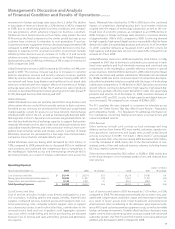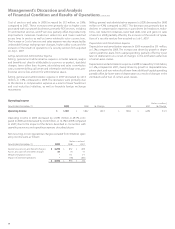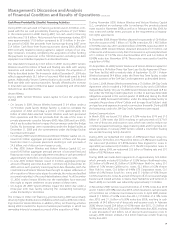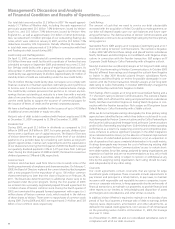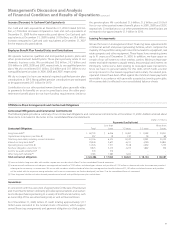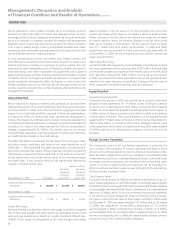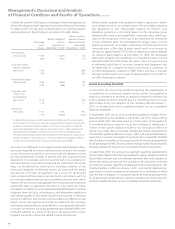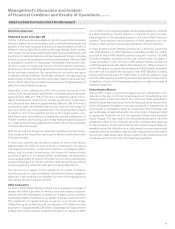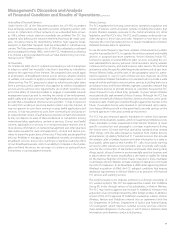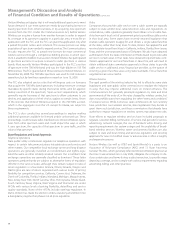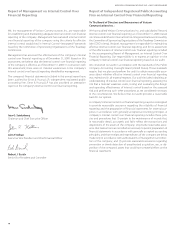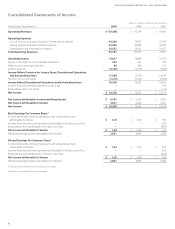Verizon Wireless 2009 Annual Report Download - page 35
Download and view the complete annual report
Please find page 35 of the 2009 Verizon Wireless annual report below. You can navigate through the pages in the report by either clicking on the pages listed below, or by using the keyword search tool below to find specific information within the annual report.
33
Goodwill
At December 31, 2009, the balance of our goodwill was approximately
$22.5 billion, of which $17.7 billion was in our Wireless segment and
$4.7 billion was in our Wireline segment. Determining whether an
impairment has occurred requires the determination of fair value of
each respective reporting unit. Our operating segments, Domestic
Wireless and Wireline, are deemed to be our reporting units for pur-
poses of goodwill impairment testing. The fair value of Domestic
Wireless significantly exceeded its carrying value. The fair value of
Wireline exceeded its carrying value. Accordingly, our annual impair-
ment tests for 2009, 2008 and 2007 did not result in an impairment.
The fair value of goodwill is calculated using a market approach and a
discounted cash flow method. The market approach includes the use
of comparative multiples to corroborate discounted cash flow results.
The discounted cash flow method is based on the present value of
two components—projected cash flows and a terminal value. The
terminal value represents the expected normalized future cash flows of
the reporting unit beyond the cash flows from the discrete projection
period. The fair value of the reporting unit is calculated based on the
sum of the present value of the cash flows from the discrete period and
the present value of the terminal value. The estimated cash flows are
discounted using a rate that represents our WACC.
With regards to the Wireline goodwill valuation, a critical assumption
includes the development of the WACC for use in our estimate of fair
value. The WACC is based on current market conditions, including the
equity-risk premium and risk-free interest rate. The projected WACC
used in the estimate of fair value in future periods may be impacted by
adverse changes in market and economic conditions, including risk-free
interest rates, and are subject to change based on the facts and circum-
stances that exist at the time of the valuation, which may increase the
likelihood of a potential future impairment charge related to Wireline
goodwill. Reducing the calculated fair value of Wireline by more than
10 percent would not have resulted in goodwill impairment.
• We maintain benefit plans for most of our employees, including pen-
sion and other postretirement benefit plans. At December 31, 2009,
in the aggregate, pension plan benefit obligations exceeded the fair
value of pension plan assets, which will result in higher future pension
plan expense. Other postretirement benefit plans have larger benefit
obligations than plan assets, resulting in expense. Significant benefit
plan assumptions, including the discount rate used, the long-term rate
of return on plan assets and health care trend rates are periodically
updated and impact the amount of benefit plan income, expense,
assets and obligations.
CRITICAL ACCOUNTING ESTIMATES AND RECENT ACCOUNTING STANDARDS
Management’s Discussion and Analysis
of Financial Condition and Results of Operations continued
Critical Accounting Estimates
A summary of the critical accounting estimates used in preparing our
financial statements is as follows:
• Wireless licenses and Goodwill are a significant component of our con-
solidated assets. Both our wireless licenses and goodwill are treated as
indefinite-lived intangible assets and, therefore are not amortized, but
rather are tested for impairment annually in the fourth fiscal quarter,
unless there are events or changes in circumstances during an interim
period that indicates these assets may not be recoverable. We believe
our estimates and assumptions are reasonable and represent appro-
priate marketplace considerations as of the valuation date. We do not
believe that reasonably likely adverse changes in our assumptions and
estimates would result in an impairment charge as of our latest impair-
ment testing date. However, if there is a substantial and sustained
adverse decline in our operating profitability, we may have impairment
charges in future years. Any such impairment charge could be material
to our results of operations and financial condition.
Wireless Licenses
The carrying value of our wireless licenses was approximately $72.1
billion as of December 31, 2009. We aggregate our wireless licenses
into one single unit of accounting, as we utilize our wireless licenses
on an integrated basis as part of our nationwide wireless network. Our
wireless licenses provide us with the exclusive right to utilize certain
radio frequency spectrum to provide wireless communication services.
There are currently no legal, regulatory, contractual, competitive, eco-
nomic or other factors that limit the useful life of our wireless licenses.
Our impairment test consists of comparing the estimated fair value of
our wireless licenses to the aggregated carrying amount as of the test
date. If the estimated fair value of our wireless licenses is less than the
aggregated carrying amount of the wireless license then an impair-
ment charge is recognized. Our annual impairment tests for 2009,
2008 and 2007 indicated that the fair value significantly exceeded the
carrying value and, therefore, did not result in an impairment.
We estimate the fair value of our wireless licenses using a direct income
based valuation approach. This approach uses a discounted cash flow
analysis to estimate what a marketplace participant would be willing
to pay to purchase the aggregated wireless licenses as of the valuation
date. As a result we are required to make significant estimates about
future cash flows specifically associated with our wireless licenses,
an appropriate discount rate based on the risk associated with those
estimated cash flows and assumed terminal value and growth rates.
We consider current and expected future economic conditions, cur-
rent and expected availability of wireless network technology and
infrastructure and related equipment and the costs thereof as well as
other relevant factors in estimating future cash flows. The discount rate
represents our estimate of the weighted average cost of capital (or
expected return, “WACC”) that a marketplace participant would require
as of the valuation date. We develop the discount rate based on our
consideration of the cost of debt and equity of a group of guideline
companies as of the valuation date. Accordingly, our discount rate
incorporates our estimate of the expected return a marketplace partici-
pant would require as of the valuation date, including the risk premium
associated with the current and expected economic conditions as of
the valuation date. The terminal value growth rate represents our esti-
mate of the marketplace’s long-term growth rate.




